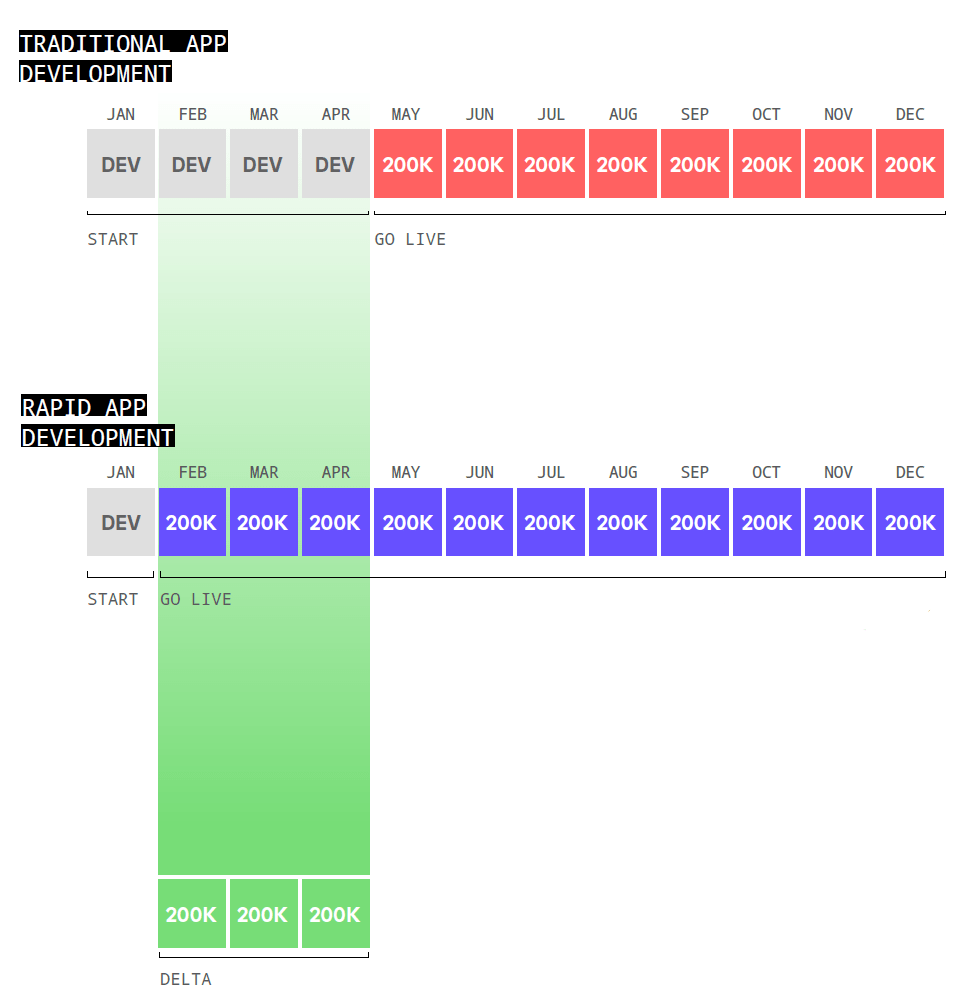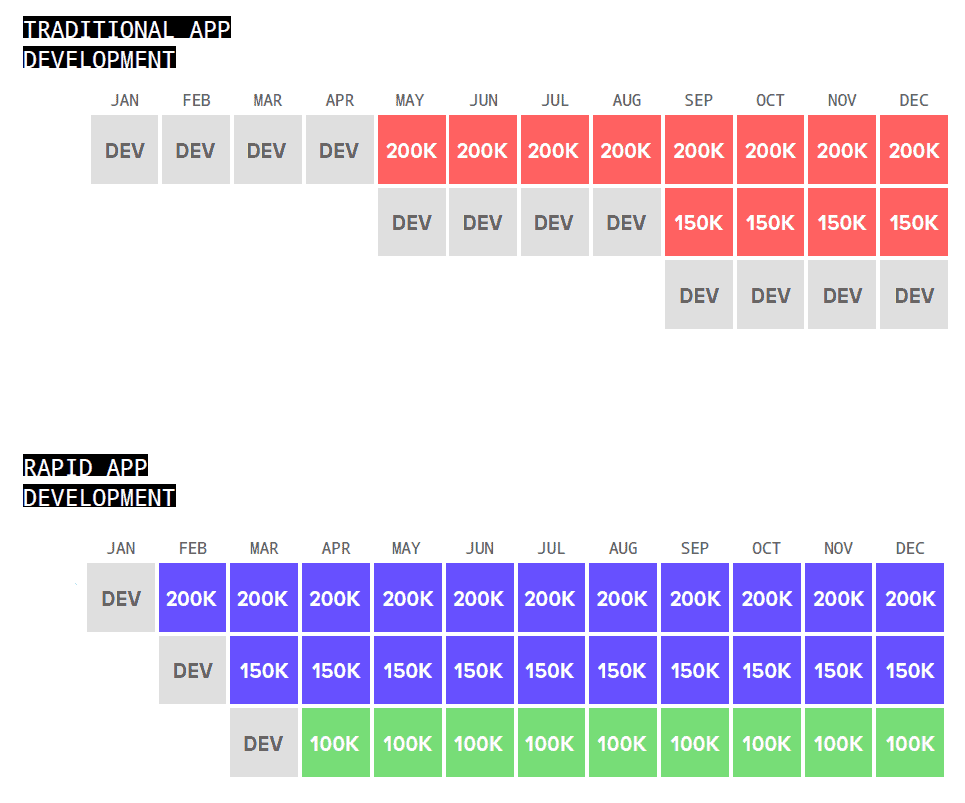There’s no doubt that software drives business value. It can generate cost savings, create revenue, or both. An e-commerce portal, for example, may digitize a face-to-face sales interaction and lead to more customers, leading to an increase in revenue. An application may automate a paper invoicing process and reduce the number of hours spent managing it down to minutes. This drives operational efficiencies, which then can save a company money.
So, if software solutions are business value-creating mechanisms, then why do we apply limits on the way they are developed and delivered? For example, according to Dimensional Research’s “Digital Disconnect” survey, 50% of IT reports inadequate budgets. 59% cite issues in supporting legacy systems.
Insufficient funding, brittle IT infrastructure, a growing backlog of requests (while the market is always more). You need to boost the value your software can realize, and traditional development methods alone aren’t going to cut it.
Low-code development is a means to amplify the value your software delivers. While easy to say, it’s not so easy to calculate. Which is important when you’re investing in a new technology. This is why we have created a framework for measuring the value of an enterprise-grade low-code platform and calculating its impact on your organization.
Low-code value: An easy concept
Low-code development allows developers in the business and IT to create, iterate, and release applications in a fraction of the time it takes with traditional development methods.
Here are just a few examples of how companies all over the world are driving business value with Mendix-built applications.
- Zurich Insurance created an application that modernized an underwriting process and realized £280,000 in operational efficiency savings per year.
- Zurich also created a new line of business with a selfie app that’s generated 63,000+ life insurance quotes in just 1 year.
- North Carolina State University delivered a non-credit course registration application that manages over 500,000 course registrations per year.
- NC State were also able to create a lab management solution that delivers $1M in new revenue per year.
- Waste management company, Suez, developed an eCommerce portal that’s delivering £500,000 in additional business.
The value of low code is intrinsically connected to the value your solutions are creating: More solutions faster means more business value sooner. Here’s how you calculate that.
Low-code value: The framework
Measuring the value of a low-code platform is important. If you’re looking to change the way you build software, you’re going to want an idea of how much return you’re getting on your low-code platform investment.
So, while the concept of low-code value is easy to imagine, it can be difficult to calculate.
Accelerate time-to-market: Value faster
Because you can develop solutions (at least) four times faster with Mendix, you can get them to market sooner.
Let’s say an application will garner you 200K in new revenue per month. Developed traditionally, it may take you four months to develop and go live. If you’re working in the calendar year and start in January, that gives you eight months of value (1.6M).
Developing in Mendix means you can go live faster and start realizing value sooner. Go live in one month instead of four, you’ve got three more months of value, or 600K more revenue (2.2M).

As we mention above, Zurich Insurance used Mendix’s low-code platform to build their underwriting application. They did so in just 12 weeks. Had they continued with their traditional methods (Waterfall methodology, traditional programming), they wouldn’t have seen impact for a year or more. The application has realized £280,000 in operational efficiency savings per year. That 280k would’ve had to wait 12 months if Zurich didn’t use low code.
In just three months using low-code development, waste management company, Suez, developed their e-commerce portal that delivered £500,000 in additional business in its first three months. The application was delivered in just three months.
A virtuous circle of value: More value, faster
With the ability to release products faster comes the ability to build more and deliver value that was heretofore unplanned for. This creates a virtuous circle of value.
Continuing from our example above, if you’re able to go live with a solution 3 months sooner, not only does that give you three months more business value, but you also have 3 more months to develop more solutions.
Using the figures from the previous example, with traditional methods, perhaps you’re only able to build two solutions in 12 months. However, with low code, you’re able to build more solutions, adding value you wouldn’t get at all with traditional methods.

After delivering their non-credit course registration application in just six months versus a quoted five years, NC State University developers were able to build the aforementioned lab management solution that cut administration time by 2/3rds and delivers $1M in new revenue per year. That’s app velocity.
Improve IT productivity
Low code also helps you improve IT efficiency. While the greater value you get from low code is found in realizing more value faster, it also helps you reduce the impact of inevitable technical debt.
Consider the total cost of ownership for one application custom developed in a full-stack, locally hosted environment over 5 years. A good amount of time is spent approving applications (product reviews, approvals, resubmissions). Time is spent in support (support from developers, business users). If you want to make enhancements or minor upgrades to your application, that’s more time spent by your developers. Time, as the old adage goes, equals money.
When you factor in reusable components, collaboration-focused IDEs, and the ability to integrate with, well, anything, you start to those hours reduced and, consequently, both CapEx and OpEx decrease.
Take, for example, a Mendix customer based out of North America. With custom development, they spent roughly 34 hours of time just on product approvals alone. Using Mendix, they shrunk that number to four. Considering the developer day rate average in the US to be ~$300, this is a significant cost saving. In a custom stack, the company spent 7.5 hours per support ticket, with 25 tickets over the application’s lifetime. With Mendix, they reduced those numbers by 40% and 60% respectively.
This is just a smattering of the increase in IT efficiency that a low-code platform like Mendix provides. The number of hours you reduce on, say, support, or the reducing developer time by building automation or reusable components, allows for developers to focus on more new opportunities.
Time to prove it
Your software solutions can deliver value no matter how you build them. With low code, you can increase that value by going to market faster, gain the ability to build more solutions, and reduce the cost of maintenance & support. Use our framework and prove it.